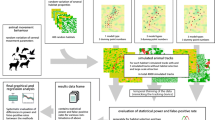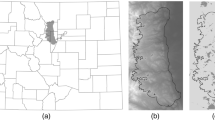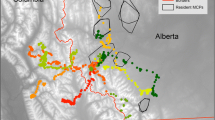Abstract
Empirical estimates of patch-specific survival and movement rates are needed to parametrize spatially explicit population models, and for inference on the effects of habitat quality and fragmentation on populations. Data from radio-marked animals, in which both the fates and habitat locations of animals are known over time, can be used in conjunction with continuous-time proportional hazards models to obtain inferences on survival rates. Discrete-time conditional logistic models may provide inference on both survival and movement rates. We use Monte Carlo simulation to investigate accuracy of estimates of survival from both approaches, and movement rates from conditional logistic regression, for two habitats. Bias was low (relative bias < 0.04) and interval coverage accurate (close to the nominal 0.95) for estimates of habitat effect on survival based on proportional hazards. Bias was high (\(\bar x\) relative bias 0.60) and interval coverage poor (\(\bar x\) = 0.26 vs. nominal 0.95) for estimates of habitat effect based on conditional logistic regression; bias was especially influenced by heterogeneity in survival and the shape of the hazard function, whereas both bias and coverage were affected by ‘memory’ effects in movement patterns. Bias estimates of movement rate was low (\(\bar x\) relative bias < 0.05), but interval coverage was poor (\(\bar x\) = 0.48–0.80), possibly as a result of poor performance of a Taylor series estimate of variance. An example is provided from a radio-telemetry study of 47 wintering American woodcock (Scolopax minor), illustrating practical difficulties in field studies to parametrize these models. We also discuss extensions of continuous-time models to explicitly include a movement process, and further examine tradeoffs between continuous and discrete models.
Similar content being viewed by others
References
Brown, C.C. (1975) On the use of indicator variables for studying the time-dependence of parameters in a response-time model.Biometrics 31, 863–72.
Brownie, C., Hines, J.E., Nichols, J.D.et al. (1993) Capture-recapture studies for multiple strata including non-Markovian transitions.Biometrics 49, 1173–87.
Conroy, M.J. (1993a) Testing hypotheses about the relationship of habitat to animal survivorship. InThe use of marked individuals in the study of bird population dynamics: models, methods, and software, J.D. Lebreton and P.M. North (eds), Birkhauser-Verlag, Basel, pp. 331–42.
Conroy, M.J. (1993b) Inference on patch-specific survival and dispersal rates from marked animals. Abstract of presentation at 1993 Annual Meeting, Ecological Society of America, 31 July-4 August 1993, Madison, Wisconsin.
Conroy, M.J., Costanzo, G.R., and Stotts, D.B. (1989) Winter survival of female American black ducks on the Atlantic Coast.Journal of Wildlife Management 53, 99–109.
Conroy, M.J., Cohen, Y., James, F.C., Matsinos, Y.G., and Mauer, B.A. (1995) Parameter estimation, reliability, and model improvement for spatially explicit models of animal populations.Ecological Applications 5, 17–19.
Cox, D.R. (1972) Regression models and life tables (with discussion).Journal of the Royal Statistical Society B34, 187–220.
Cox, D.R. (1975) Partial likelihood.Biometrika 62, 209–76.
Cox, D.R. and Oakes, D. (1984) Analysis of survival data. Chapman & Hall, London.
Dunning, J.B., Stewart, D.J., Danielson, B.J.et al. (1995) Spatially-explicit population models: current forms and future uses.Ecological Applications 5, 3–11.
Gavin, T. (1991) Why ask ‘why’: the importance of evolutionary biology in wildlife science.Journal of Wildlife Management 55, 760–8.
Hestbeck, J.B., Nichols, J.D., and Malecki, R.A. (1991) Estimates of movement and site fidelity using markresight data of wintering Canada geese.Ecology 72, 523–33.
Kaplan, E.L. and Meier, P. (1958) Nonparametric estimation from incomplete observations.Journal of the American Statistical Association 53, 457–81.
Krementz, D.G., Seginak, J.T., Smith, D.R., and Pendleton, G.W. (1994) Survival rates of American woodcock along the Atlantic coast.Journal of Wildlife Management 58, 147–55.
Murphy, D.D. and Noon, B.R. (1991) Coping with uncertainty in wildlife biology.Journal of Wildlife Management 55, 773–82.
Myers, M.H., Hankey, B.F., and Mantel, N. (1973) A logistic-exponential model for use with response-time data involving regressor variables.Biometrics 29, 257–69.
Pollock, K.H., Winterstein, S.R., Bunck, C.M., and Curtis, P.D. (1989a) Survival analysis in telemetry studies: the staggered entry design.Journal of Wildlife Management 53, 7–15.
Pollock, K.H., Winterstein, S.R., and Conroy, M.J. (1989b) Estimation and analysis of survival distributions for radio-tagged animals.Biometrics 45, 99–109.
Pulliam, H.R. (1988) Sources, sinks, and population regulation.American Naturalist 132, 652–61.
SAS (1988)SAS Technical Report: P-179. Additional SAS/STAT procedures. SAS Institute, Inc. Cary, NC.
SAS (1991)SAS/STAT Software: the PHREG procedure. Preliminary documentation. SAS Institute, Inc. Cary, NC.
Seber, G.A.F. (1982)The estimation of animal abundance and related parameters (2nd edn). Grin, London.
Van Horne, B. (1983) Density as a misleading indicator of habitat quality.Journal of Wildlife Management 47, 893–901.
Author information
Authors and Affiliations
Rights and permissions
About this article
Cite this article
Conroy, M.J., Anderson, J.E., Rathbun, S.L. et al. Statistical inference on patch-specific survival and movement rates from marked animals. Environ Ecol Stat 3, 99–116 (1996). https://doi.org/10.1007/BF02427854
Received:
Revised:
Issue Date:
DOI: https://doi.org/10.1007/BF02427854




